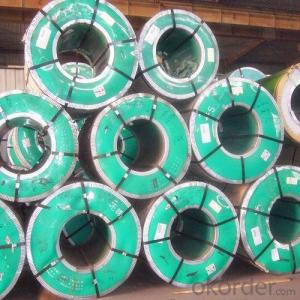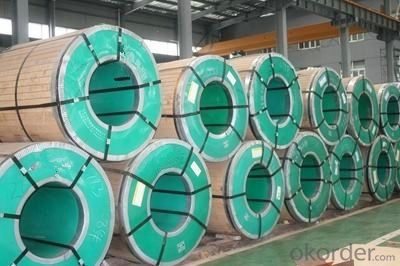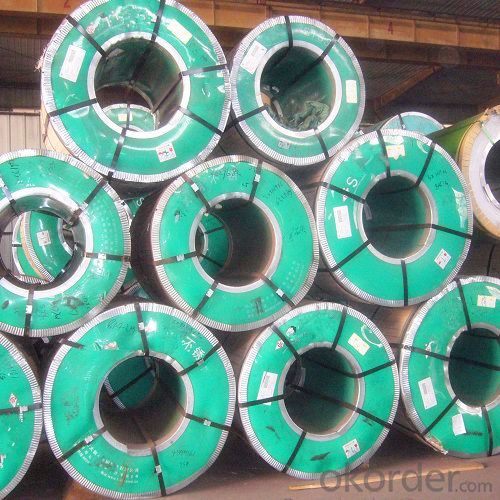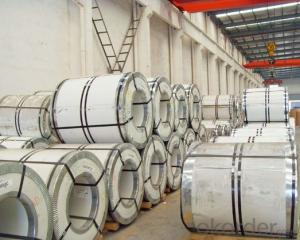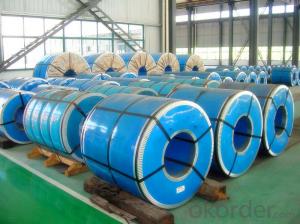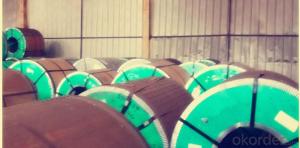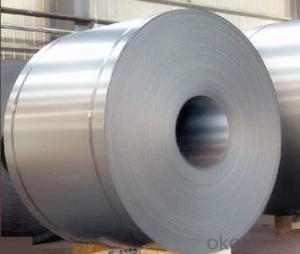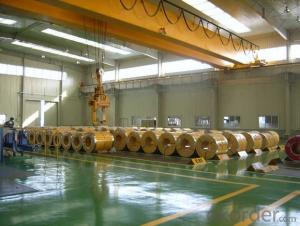Stainless Steel Coil 304 Hot Rolled Wide / Narrow No.1 Surface Finish
- Loading Port:
- Guangzhou
- Payment Terms:
- TT OR LC
- Min Order Qty:
- 100 m.t.
- Supply Capability:
- 8000 m.t./month
OKorder Service Pledge
OKorder Financial Service
You Might Also Like
Grade: | 300 Series | Standard: | JIS,AISI,ASTM,GB,DIN,EN etc | Thickness: | 2.5mm, 3.0mm, 4.0mm |
Width: | 550mm-1500mm | Length: | according to weight | Place of Origin: | China (Mainland) |
Brand Name: | CNBM | Model Number: | 304 | Technique: | Hot Rolled |
Application: | industry, construction, furniture, repairing | Certification: | MTC | Finishing: | NO.1 |
Market: | globle area | Packaged: | wooden and bags in cases as standard | Payment: | TT & LC |
Delivery time: | 15 days | MOQ: | 100 tons | Advantage: | prime quality, competitive price |
Profession: | hot rolled | Charactor: | stainless steel coils | Material/Grade: | 304 |
Hot Rolled Stainless Steel Coil 304 Annealing and Pickling No.1 Finish
Stainless steel is a production which not easy rust,acid resistance and corrosion resistance,so it is widely
used in light industry,heavy industry,daily necessities and the decoration industry.
Hot Rolled Stainless Steel Coil 304 Specifications
1.surface:NO.1
2.standard:JIS, AISI, GB
3.width: 0.55m, 0.65m, 1.0m, 1.22m, 1.5m, 2m or requirement
Hot Rolled Stainless Steel Coil 304 Chemical Composition:
(%):C=0.07, Mn=2.00, P=0.045, S=0.030, Si=0.075, Cr=17.5-19.5, Ni=8.0-10.5, N=0.10
Hot Rolled Stainless Steel Coil 304 Physical Properties
Tensile strength σb (MPa) ≥ 520
the conditions yield strength σ0.2 (MPa) ≥ 205,
elongation δ5 (%) ≥ 40
Reduction of ψ (%) ≥ 50,
hardness: ≤ 187
HB; ≤ 90
HRB; ≤ 200H
- Q: Can stainless steel strips be used in the pharmaceutical manufacturing industry?
- Stainless steel strips are indeed applicable for use in the pharmaceutical manufacturing sector. The pharmaceutical industry frequently employs stainless steel due to its impressive resistance to corrosion, durability, and hygienic qualities. In the production of various pharmaceutical equipment like tanks, vessels, piping, and machinery, stainless steel strips are commonly utilized. These strips possess excellent resistance to chemicals, heat, and moisture, which renders them suitable for the stringent hygiene and cleanliness requirements of the pharmaceutical manufacturing process. Moreover, stainless steel is easy to clean and maintain, ensuring the prevention of contamination and the maintenance of a sterile environment. All in all, the pharmaceutical industry favors stainless steel strips due to their dependability, longevity, and adherence to regulatory standards.
- Q: Are stainless steel strips suitable for outdoor sculptures?
- Yes, stainless steel strips are suitable for outdoor sculptures. Stainless steel is known for its durability, corrosion resistance, and ability to withstand harsh weather conditions. These properties make it an excellent choice for outdoor sculptures as it can withstand exposure to moisture, UV rays, and temperature fluctuations without rusting or deteriorating. Additionally, stainless steel's sleek and modern appearance can enhance the aesthetic appeal of outdoor sculptures.
- Q: What are the typical hardness values of stainless steel strips?
- The typical hardness values of stainless steel strips can vary depending on the specific grade and type of stainless steel being used. However, stainless steel strips generally have a hardness range between 150 and 250 on the Vickers hardness scale (HV). Some grades of stainless steel may have higher hardness values, reaching up to 300 HV or more, while others may have lower hardness values, closer to the lower end of the range. It is important to note that the hardness of stainless steel strips can also be influenced by factors such as the heat treatment process and the thickness of the strip.
- Q: What are the recommended safety guidelines for cutting 111 stainless steel strips?
- When cutting 111 stainless steel strips, it is important to follow recommended safety guidelines to minimize the risk of injury. Here are some guidelines that are commonly recommended: 1. Personal Protective Equipment (PPE): Always wear appropriate PPE such as safety glasses or goggles to protect your eyes from flying debris, and gloves to protect your hands from sharp edges or potential cuts. 2. Use the Right Tools: Ensure that you are using the correct cutting tool for stainless steel strips. This could include tools like a metal cutting circular saw or a plasma cutter. Make sure the tool is in good condition and properly maintained. 3. Secure the Material: Secure the stainless steel strip properly before cutting to prevent movement or slipping during the process. This can be achieved by using clamps or a vise to hold the strip securely in place. 4. Clear the Work Area: Ensure that the work area is clean and free of any obstructions or hazards that could cause accidents. Remove any loose objects or debris that could interfere with the cutting process. 5. Follow Proper Technique: When cutting, use a steady and controlled motion to prevent the tool from binding or jumping. Always cut away from your body and avoid any sudden movements that may result in injury. 6. Watch for Heat Build-up: Cutting stainless steel can generate a significant amount of heat. Be cautious of this heat build-up and avoid touching the material immediately after cutting to prevent burns. 7. Allow for Cooling: After cutting, allow the stainless steel strip to cool down before handling it further. This will reduce the risk of burns and ensure safe handling. 8. Proper Disposal of Waste: Dispose of any waste material, such as scraps or cuttings, in appropriate containers or designated areas to prevent accidents or injuries. It is important to note that these guidelines may vary depending on the specific cutting method and equipment being used. Always refer to the manufacturer's instructions and seek professional advice if necessary to ensure the highest level of safety when cutting stainless steel strips.
- Q: What is the cost of stainless steel strips compared to other materials?
- The cost of stainless steel strips can vary depending on factors such as the grade of stainless steel, the thickness and width of the strips, and the quantity being purchased. In general, stainless steel strips tend to be more expensive compared to other materials such as aluminum or carbon steel. This is primarily due to the higher cost of raw materials and the additional processing required to manufacture stainless steel. However, the durability, corrosion resistance, and aesthetic appeal of stainless steel make it a popular choice in various industries, including construction, automotive, and manufacturing. While stainless steel strips may have a higher upfront cost, they often provide long-term cost savings due to their longevity and low maintenance requirements.
- Q: Can stainless steel strips be used in food processing equipment?
- Yes, stainless steel strips can be used in food processing equipment. Stainless steel is widely used in the food industry because it is resistant to corrosion, easy to clean, and does not react with food.
- Q: Are stainless steel strips suitable for laser cutting?
- Yes, stainless steel strips are suitable for laser cutting. Laser cutting is a highly precise and efficient method of cutting various materials, including stainless steel. The high energy density of the laser beam allows for a clean and accurate cut, without causing any distortion or damage to the metal. Stainless steel, known for its corrosion resistance and durability, is a popular material choice for many industries, including automotive, aerospace, and construction. Laser cutting offers several advantages for stainless steel strips, such as reducing material waste, maintaining tight tolerances, and enabling intricate designs. Additionally, laser cutting provides a smooth and burr-free edge finish, enhancing the aesthetic appeal of the stainless steel strips.
- Q: How do you remove scratches from stainless steel strips?
- To remove scratches from stainless steel strips, you can try a few methods: 1. Start by cleaning the surface with warm soapy water and a soft cloth. This will help remove any dirt or grime that may be masking the scratches. 2. Use a non-abrasive stainless steel cleaner or a mixture of baking soda and water. Apply the cleaner to a soft cloth and gently rub it onto the scratched area in a circular motion. Be sure to follow the grain of the stainless steel to avoid further damage. 3. For deeper scratches, you can use a stainless steel scratch remover or a metal polishing compound. Apply a small amount of the product onto a clean cloth and rub it into the scratch using a circular motion. Continue rubbing until the scratch fades or disappears. Make sure to wipe off any excess product and rinse the area with water. 4. Another option is to use a fine-grit sandpaper or a stainless steel polishing pad. Start with a lower grit sandpaper (around 400) and gently rub it over the scratch in the direction of the grain. Gradually move to higher grit sandpaper (800, 1000) for a smoother finish. Remember to clean the surface afterwards to remove any residue. 5. If the scratches are too deep or extensive, it may be necessary to hire a professional to repair or replace the stainless steel strips. Remember to always test any cleaning or polishing method on a small, inconspicuous area first to ensure it doesn't cause any damage.
- Q: Are stainless steel strips easy to clean?
- Yes, stainless steel strips are easy to clean. Stainless steel is known for its non-porous and smooth surface, which makes it resistant to stains and easy to wipe clean. You can simply use a mild detergent or soap and water to clean stainless steel strips. Additionally, stainless steel is also heat-resistant, so you can use various cleaning methods like steam cleaning or even sterilizing them in boiling water. Overall, stainless steel strips are a low-maintenance material that is durable and easy to keep clean.
- Q: Can stainless steel strips be used in the food processing industry?
- Indeed, the food processing industry is able to utilize stainless steel strips. This particular material, known for its exceptional durability and resistance to corrosion, finds wide application in the realm of food processing. Stainless steel possesses a smooth surface that hinders bacteria accumulation, is easily cleaned, and can withstand both extreme temperatures and exposure to chemicals. In the food processing industry, stainless steel strips serve numerous functions, including the construction of conveyor belts, equipment components, food preparation surfaces, and storage containers. Furthermore, they adhere to the industry's rigorous hygiene and safety standards, making them a favored option due to their reliability and long-lasting nature.
Send your message to us
Stainless Steel Coil 304 Hot Rolled Wide / Narrow No.1 Surface Finish
- Loading Port:
- Guangzhou
- Payment Terms:
- TT OR LC
- Min Order Qty:
- 100 m.t.
- Supply Capability:
- 8000 m.t./month
OKorder Service Pledge
OKorder Financial Service
Similar products
Hot products
Hot Searches
Related keywords

